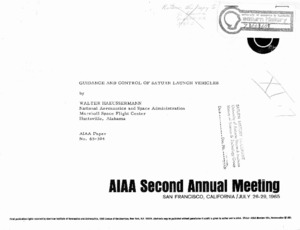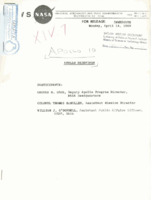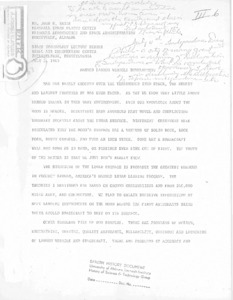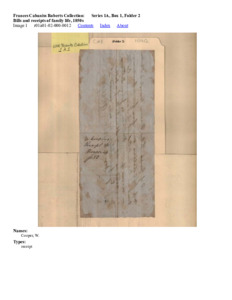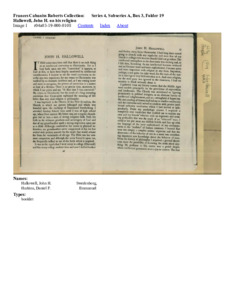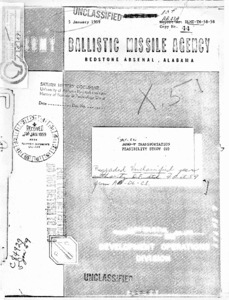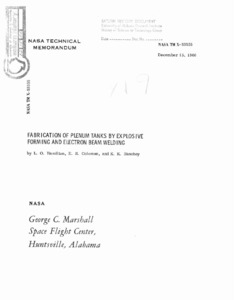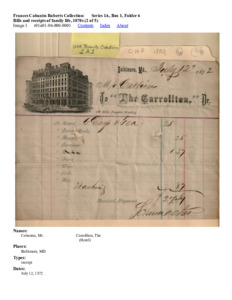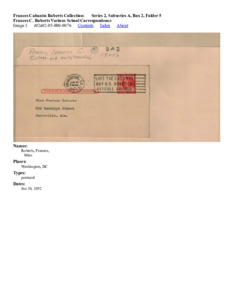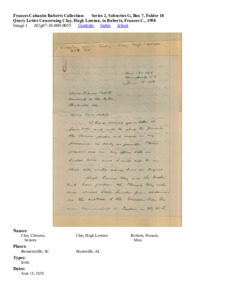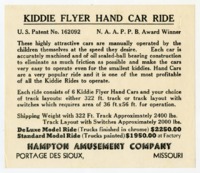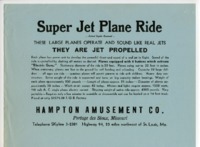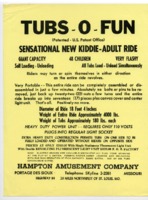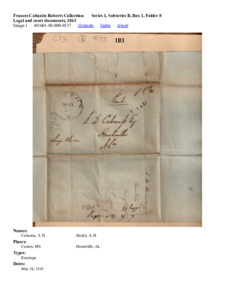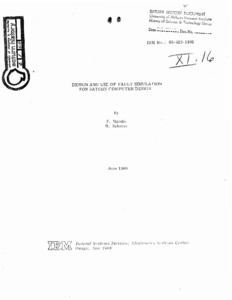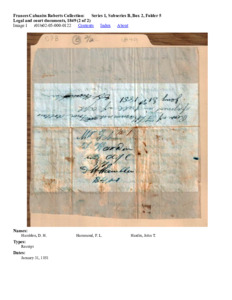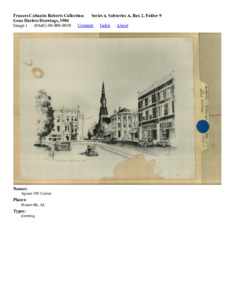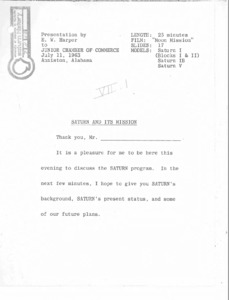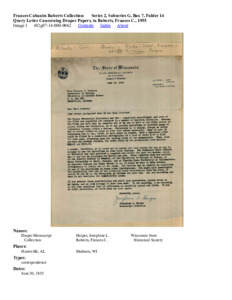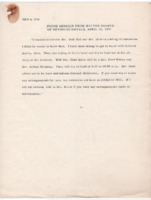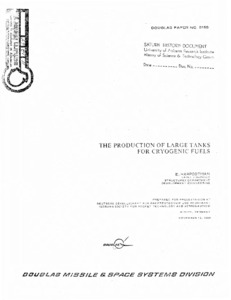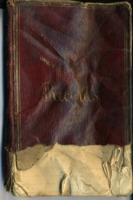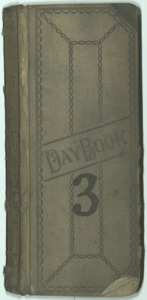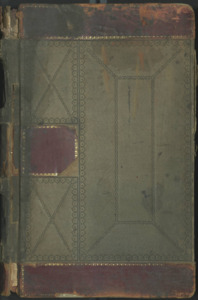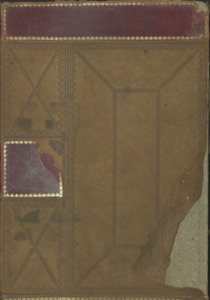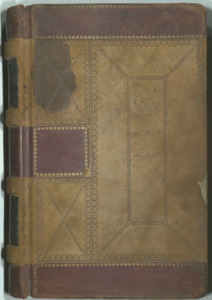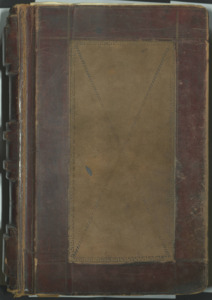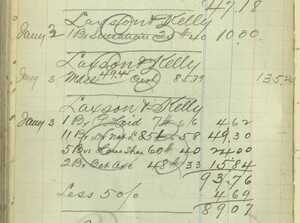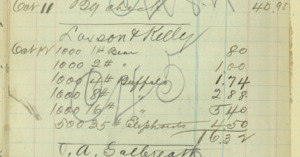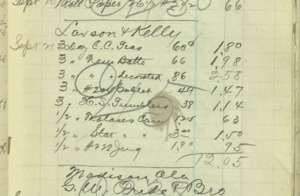
Browse Items (7888 total)
-
"Guidance and Control of Saturn Launch Vehicles."
The navigation, guidance, and control modes and problems of the Saturn launch vehicles are given as the requirements for the guidance and control methods. Two path adaptive guidance modes, featuring flight path optimization, in the form of a polynomial mode and an iterative mode are given in their computation form and compared with respect to mission flexibility, implementation requirements, and performance. Attitude control during the propelled flight phases requires consideration of various bending and sloshing modes; stability of the control system is obtained by phase stabilization of the low frequencies and by attenuation of the higher frequencies. Typical shaping networks and their transfer functions are given. The attitude control system during coasting periods is briefly described. The functional behavior and characteristic data of the main guidance and control hardware such as the inertial sensors, stabilized platform, digital computer, data adapter, control computer, and actuation system are described. Reliability requirements are emphasized. The principle of redundancy is extensively used to obtain highest reliability for long operating times. Data and results from recent Saturn I flights summarize the performance of the guidance schemes. -
Briefing for Apollo 10.
This document contains a transcript of the briefing meeting for the launch of Apollo 10. Participants include George H. Hage, Colonel Thomas McMullen, and William J. O'Donnell. -
"Nondestructive testing of space vehicle liquid propellant rocket engines."
Presented at the Western Metals Congress, Los Angeles, California, 15 March 1967.; Archive copy is a photocopy.; ABSTRACT: This report describes the various nondestructive test methods employed to evaluate materials and processes used in the manufacture of large liquid propellant rocket engines at the Rocketdyne Division of North American Aviation, Inc. The contents of the paper were purposely oriented for an audience of aerospace, design and materials engineers. A brief description of liquid propellant rocket engine reliability is presented. The relationship of standards and specifications to nondestructive testing is discussed and various test methods are described along with a discussion of their applications and limitations. The sequence of events leading up to the use of nondestructive testing in production inspection is presented. Finally, the organization of labor directly related to nondestructive testing is given. -
"Manned Launch Vehicle Development."
Includes handwritten notes. Includes references to slides. Essay remarking on how space vehicles will interact on the moon's surface. -
Oral History Interview With Steven Hall
Steven Hall was born in a small town in the north central part of Indiana. This town has about a population of 2,000 people. Steven graduated from Eastern High School in 1963, and then he enrolled in Aeronautical/Neurospace Engineering at Purdue University. There, he received his bachelor's degree in 1968. Steven originally became interested in man space-flight when he was just about 10 years old. At this age, he had no clue how he could get involved with the space station, but he knew that he wanted to get involved one day. After he graduated college, he was so ready to work at NASA, that he left his home town immediately to move down to Huntsville, AL to start working. When he began working at the Marshall Space Flight Center, he was shown how Human Factors Engineering worked. One of the first projects that Steven was able to work on was "Skylab" where they built a lot of the equipment that probed how humans responded to space, and how the body changes in space. He also worked on a program to design a vehicle to drive around the surface of the moon.Tags Oral History -
Oral History Interview With George Hamilton
George Hamilton has lived in Huntsville, Alabama all of his life, and his father was a Charter Marshall Member in Huntsville. When he was working, George's father was chosen as a "guinea pig" to go up in the Pregnant Guppy, which was a large, wide-bodied cargo aircraft. Because of George's father's career and interest with NASA, it made George interested in the career as well. George has a lot of family stories like this, which all have inspired him to take on his career that he has now. After high school, George went to The University of South Alabama in Mobile to study Marine Biology. Over the summer he had a change of heart, so he decided to transfer to Auburn University for Mechanical Engineering. After he finished up with his degree, he started working in small, manufacturing spare parts for missiles. After this career, he started to work at Avco Electronics in Huntsville where he worked at the plant on the design side. After this, Avco started looking for people to go overseas on the construction side of the house, so George went overseas with them. Then he came back, got married, and received his Phd in Biomedical Engineering at The University of Alabama in Birmingham.Tags Oral History -
"Juno V Transportation Feasibility Study (U)."
The purpose of this report is to present an investigation to determine the feasible, practical and economical method of transporting the JUNO V thrust unit. This includes the first phase of transporting between Fabrication Laboratory, Systems Analysis and Reliability Laboratory and to the test stand, as well as the later phases, onto the Redstone Arsenal loading docks and from there down the Tennessee, Ohio and Mississippi Rivers to the Atlantic Missile Range, Florida.; Transportation and Packaging Section, Systems Support Equipment Laboratory. -
"Fabrication of Plenum Tanks by Explosive Forming and Electron Beam Welding."
This report presents the results of a program initiated to study the use of explosive forming and electron beam fusion welding techniques in the fabrication of pressurized cryogenic materials containers. Using these techniques, vessels were successfully formed from 304 stainless steel and X7106 aluminum alloy in the T63 condition.; Manufacturing Research and Technology Division.; Manufacturing Engineering Laboratory.; Research and Development Operations. -
"Kiddie Flyer Hand Car Ride."
The advertisement gives a description of the ride, its shipping weight, and its price. -
"Super Jet Plane Ride."
The advertisement gives a description of the ride, its shipping weight, and its price. -
"Tubs-O-Fun"
The advertisement gives a features and specifications of the ride, its shipping weight, and its price. -
"Design and Use of Fault Simulation for Saturn Computer Design."
Describes different aspect of the Fault Simulation for Saturn computer design. -
"Saturn and its mission."
Presentation from Harper, discussing the Saturn Project's then-status, background and plans. -
Phone message to Robert K. Bell from Walter Harper.
In this transcript of the phone message to Bell from Walter Harper of Reynolds Metals, Bell is informed that Mr. Hunt will be arriving the following day and will try to land at the air strip at Redstone Arsenal. This information was asked to be passed on to Colonel Nickerson. -
"The production of large tanks for cryogenic fuels"
Archive copy is a poor photocopy. Prepared for presentation at Deutsche Gesellschaft fur Raketentechnik und Raumfahrt. (German Society for Rocket Technology and Astronautics). Given by E. Harpoothian, Chief Engineer, Structures Department, Development Engineering.; Tanks for cryogenic fluids, as used in the Saturn space vehicles, have reached an advanced stage of design and development. Many of the structural features of the NASA/Douglas Saturn tanks, fabricated of 2014-T6 aluminum alloy, were first developed for the booster of the Thor ballistic missile, which later found extensive use in putting space vehicles into orbit. There is a mutual dependence of important factors related to design concepts, selection of materials, processing techniques, and fabrication methods. It is shown that this mutual dependence must be considered if a successful vehicle is to emerge from design and development. Details of vehicle structure, provision for insulation, and manufacturing methods are presented. Criteria for the selection of materials is shown to be dependent on strength, ductility, weldability, toughness, fabricability, behavior at cryogenic temperatures, and on manufacturing methods and inspection techniques. -
Civil War diary of George Washington Harris.
Harris served as a private in Company F of the 149th Indiana Infantry Regiment, which occupied Decatur, Alabama in 1865. He enrolled at Terre Haute, Indiana, on February 15, 1865 at the age of twenty. Harris records his experiences as a soldier and traces his journey south to Decatur. Harris also describes his interactions with locals in North Alabama, writing in April 1865 that he "halted to talk with a family of Rebbs questioning concerning their so-called independence but found out nothing of importance Except that ther hopes had fled." He also includes descriptions of skirmishes in which he took part, as well as lengthy descriptions of the terrain and weather. Harris adds his comments on the assassination of Abraham Lincoln and writes down song lyrics and poetry at points. Harris was discharged on September 27, 1865. -
Transcript of the Civil War diary of George Washington Harris.
Harris served as a private in Company F of the 149th Indiana Infantry Regiment, which occupied Decatur, Alabama in 1865. He enrolled at Terre Haute, Indiana, on February 15, 1865 at the age of twenty. Harris records his experiences as a soldier and traces his journey south to Decatur. Harris was discharged on September 27, 1865. The transcription includes a key to the cipher that Harris sometimes used, as well as notes and clarifications in brackets and parentheses. Also included are the complete lyrics to the Union song "Reply to the Bonnie Blue Flag," part of which Harris records in an entry here. -
Harrison Brothers Hardware Company daybook 1, 1896-1898.
This daybook contains the Harrison Brothers' daily store transactions from June 4, 1896, to March 29, 1898. The store was not open on Sundays or holidays. The Harrison Brothers sold exclusively tobacco products such as cigarettes, cigars, chewing tobacco, leaf tobacco, and tobacco-related products until 1900. The store moved from its original location on Jefferson St. to #3 Southside Square in 1897.
Each page in the Harrison Brothers daybooks is divided into columns for the date, transaction details, and debit and credit sales. The year is listed in the upper left-hand corner of each page and the month and day are listed in the column below on the left side of each transaction. Individual transactions are separated by horizontal lines at the end of each page. Each transaction includes where the customer was from (for example: "Tuscumbia Ala"), the name of the customer (for example: "W.L. Halsey", "Mrs. Lizzie Barclift", or "Goldsmith + Co."), the items that the customer bought and the rate at which they were sold (for example: "1Bx Spot Cash 25#50"), the total cost of the sale, the customer's method of payment (for example: "By Cash", "By Check", "By Mdse.", "By Work", or by credit if no payment method is listed), and the customer account number. The customer account numbers correlate to a page number in the Harrison Brother's Customer Account Ledgers where customer's store accounts are divided into debit and credit columns. This day book references accounts in Customer Account Ledger 1 located in The University of Alabama in Huntsville Archives and Special Collections. Debit and credit columns also appear in the daybooks on the right side of the page. Transactions are added up in the "D" column and payments are recorded in the "C" column. Employee information, invoices, inventory, assets, and liabilities for the Harrison Brothers store are included at the back of the daybook from pages 480-500.
-
Harrison Brothers Hardware Company daybook 2, 1898-1902.
This daybook contains the Harrison Brothers' daily store transactions from March 29, 1898, to January 13, 1902. The store was not open on Sundays or holidays. The Harrison Brothers sold exclusively tobacco products such as cigarettes, cigars, chewing tobacco, leaf tobacco, and tobacco-related products until 1900. In March 1900, the Harrison Brothers began selling assorted sets of china dishes and continued to sell primarily Queensware and other home furnishing-related products until 1903 when the store began selling hardware. The store moved from its original location on Jefferson St. to #3 Southside Square in 1897. In December 1901, a fire damaged the front of the Harrison Brothers' number 3 Southside Square storefront as well as other buildings along the street.
Each page in the Harrison Brothers daybooks is divided into columns for the date, transaction details, and debit and credit sales. The year is listed in the upper left-hand corner of each page and the month and day are listed in the columns below on the left side of each transaction. Each transaction includes where the customer was from (for example: "Tuscumbia Ala"), the name of the customer (for example: "W.L. Halsey", "Mrs. Lizzie Barclift", or "Goldsmith + Co."), the items that the customer bought and the rate at which they were sold (for example: "1Bx Spot Cash 25#50" and "1/2Doz #0 Lanterns 5.00"), the total cost of the sale, the customer's method of payment (for example: "By Cash", "By Check", "By Mdse.", "By Work", "By Note" or by credit if no payment method is listed), and the customer account number. If the customer worked in a local cotton mill, the name of the mill is listed next to the customer name such as "Dallas" for Dallas Mills and "West Huntsville" or "W.H." for West Huntsville Manufacturing Company. The customer account numbers reference page numbers in the Harrison Brother's Customer Account Ledgers where customer's store accounts are divided into debit and credit columns. This day book references accounts in Customer Account Ledger 1 located in The University of Alabama in Huntsville Archives and Special Collections. Many accounts do not list customer account numbers if paid for in full with cash or note. These transactions are written over with two ##s or three Cs. Debit and credit columns also appear in the daybooks on the right side of the page. Transactions are added up in the "D" column and payments are recorded in the "C" column. Employee information, invoices, inventory, assets, and liabilities for the Harrison Brothers store are included at the back of the daybook from pages 738-800.
-
Harrison Brothers Hardware Company daybook 3, 1901-1903.
This daybook contains the Harrison Brothers' daily store transactions from January 2, 1902, to December 31, 1903. The store was not open on Sundays or holidays. The Harrison Brothers sold exclusively tobacco products such as cigarettes, cigars, chewing tobacco, leaf tobacco, and tobacco-related products until 1900. In March 1900, the Harrison Brothers began selling assorted sets of china dishes and continued to sell primarily Queensware and other home furnishing-related products until the end of 1903 when the store began selling hardware products such as stoves and pipes. The store moved from its original location on Jefferson St. to #3 Southside Square in 1897. In December 1901, a fire damaged the front of the Harrison Brothers' number 3 Southside Square storefront as well as other buildings along the street. In 1902, the Harrison Brothers hired local contractors and masons, such as Daniel Brandon, to repair the damage and expand the storefront. The Harrison Brothers purchased the number 2 Southside Square storefront the same year and began operating both storefronts in 1904.
Each page in the Harrison Brothers daybooks is divided into columns for the date, transaction details, and debit and credit sales. The year is listed in the upper left-hand corner of each page and the month and day are listed in the column below on the left side of each transaction. Each transaction includes where the customer was from (for example: "Tuscumbia Ala"), the name of the customer (for example: "W.L. Halsey", "Mrs. Lizzie Barclift", or "Goldsmith + Co."), the items that the customer bought and the rate at which they were sold (for example: "1Bx Spot Cash 25#50" and "1/2Doz #0 Lanterns 5.00"), the total cost of the sale, the customer's method of payment (for example: "By Cash", "By Check", "By Mdse.", "By Work", "By Note" or by credit if no payment method is listed), and the customer account number. If the customer worked in a local cotton mill, the name of the mill is listed next to the customer name such as "Dallas" for Dallas Mills, and "West Huntsville" or "W.H." for West Huntsville Manufacturing Company. The customer account numbers reference page numbers in the Harrison Brother's Customer Account Ledgers where customer's store accounts are divided into debit and credit columns. The Customer Account Ledgers referenced by this daybook are located in The University of Alabama in Huntsville Archives and Special Collections. Many accounts do not list customer account numbers if paid for in full with cash or note. These transactions are written over with two ##s or three Cs. Debit and credit columns also appear in the daybooks on the right side of the page. Transactions are added up in the "D" column and payments are recorded in the "C" column. Employee information, invoices, inventory, assets, and liabilities for the Harrison Brothers store are included at the back of the daybook from pages 463-500. Information about the contractors that restored Harrison Brothers in 1902 can be found on pages 484 and 500.
-
Harrison Brothers Hardware Company daybook 4, 1904-1905.
This daybook contains the Harrison Brothers' daily store transactions from January 1, 1904, to December 31, 1905. The store was not open on Sundays or holidays. During these years the Harrison Brothers were no longer selling tobacco products. After renovating the number 3 Southside Square storefront and purchasing the number 2 storefront in 1902, the Harrison Brothers continued to sell china products such as dish assortments, glass products such as lamps, enameled steelware such as pots and pans, cutlery, and some hardware products such as stoves and pipes in 1904. At the end of 1904, the Harrison Brothers began to sell furniture such as rockers, chairs, beds, and window shades in the number 3 storefront and continued to sell Queensware in number 2. The store's furniture inventory expanded in 1905 to include mirrors, cradles, baby buggies, stove ranges, and cooking appliances such as waffle irons.
Each page in the Harrison Brothers daybooks is divided into columns for the date, transaction details, and debit and credit sales. The year is listed in the upper left-hand corner of each page and the month and day are listed in the column below on the left side of each transaction. Each transaction includes the name of the customer (for example: "W.L. Halsey", "Mrs. Lizzie Barclift", or "Goldsmith + Co."), the items that the customer bought, the total cost of the sale, the customer's method of payment (for example: "By Cash", "By Check", "By Mdse.", "By Work", "By Note" or by credit if no payment method is listed), and the customer account number. Some transactions include where the customer was from (for example: "Tuscumbia Ala") or, if the customer worked in a local cotton mill, the name of the mill is listed next to the customer name such as "Merrimac" or "M" for Merrimack Manufacturing Co., "Dallas" or "D" for Dallas Mills, and "Lowe Mill" or "LM" for Lowe Mill. The customer account numbers correlate to a page number in the Harrison Brother's Customer Account Ledgers where customer's store accounts are divided into debit and credit columns. This day book references accounts in Customer Account Ledger 1 located in The University of Alabama in Huntsville Archives and Special Collections and another ledger located in the Huntsville-Madison County Public Library Special Collections. Many accounts do not list customer account numbers if paid for in full with cash or note. These transactions are written over with two ##s. Debit and credit columns also appear in the daybooks on the right side of the page. Transactions are added up in the "D" column and payments are recorded in the "C" column. Employee information, invoices, inventory, assets, and liabilities for the Harrison Brothers store are included at the back of the daybook from pages 460-500.
-
Harrison Brothers Hardware Company customer account ledger 1, 1897-1904.
This Customer Account Ledger contains the credit account information for Harrison Brothers customer transactions from 1898-1904. The index at the front of the ledger is organized alphabetically by the customer's last name. Each index page is dived into two columns. The left column lists the name of the customer and the right column lists the customer's city of residence and the page number of the customer's account. The page numbers reference pages in the ledger where one or multiple accounts are listed. Each customer account page is divided into a debit "D" and credit "C" column separated by a blue line. The customer's name and city of residence are written at the top of each account. In the debit column, the year is written at the top left and months and days of transactions are listed below in the first two columns. The next two columns reference a customer's transactions in a particular daybook listed as "B B #" and the page number that the transaction is listed on. This ledger references transactions in daybooks 1, 2, and 3 located in the University of Alabama in Huntsville Archives and Special Collections. In the credit column, the month and day of a customer's payments are listed in the first two columns. The next two columns list the daybook and the page number that the customer's payment is recorded on. The payment amount is listed in the rightmost column of the page. The debit and credit columns are either balanced at the bottom of the page or the Harrison Brothers indicated that the customer account was carried to a new page in the ledger.
-
Harrison Brothers Hardware Company customer account ledger 2, 1889-1896.
This Customer Account Ledger contains the credit account information for Harrison Brothers customer transactions from 1889-1896. The index at the front of the ledger is organized alphabetically by the customer's last name. Each index page is dived into two columns. The left column lists the name of the customer and the right column lists the customer's city of residence and the page number of the customer's account. The page numbers reference pages in the ledger where one or multiple accounts are listed. Each customer account page is divided into a debit "D" and credit "C" column separated by a blue line. The customer's name and city of residence are written at the top of each account. In the debit column, the year is written at the top left and months and days of transactions are listed below in the first two columns. The next column references a customer's transactions in a particular daybook listed as "B B #" and the page number in the referenced book is listed in the following column. This ledger references transactions in daybooks 1 and 2. These daybooks, not included in the collection of account books at the University of Alabama in Huntsville Archives and Special Collections, likely recorded tobacco sales from the Harrison Brothers store on Jefferson Street prior to their move to Southside Square in 1897. In the credit column, the month and day of a customer's payments are listed in the first two columns. The next two columns list the daybook and the page number that the customer's payment is recorded on. The payment amount is listed in the rightmost column of the page. The debit and credit columns are either balanced at the bottom of the page or the Harrison Brothers indicated that the customer account was carried to a new page in the ledger. Many pages in this ledger are empty and customer accounts begin on page 214.
-
Harrison Brothers Hardware Company customer account ledger 4, 1889-1893.
This Customer Account Ledger contains the credit account information for Harrison Brothers customer transactions from 1889-1893 The index at the front of the ledger is organized alphabetically by the customer's last name. Each index page is dived into two columns. The left column lists the name of the customer and the right column lists the customer's city of residence and the page number of the customer's account. The page numbers reference pages in the ledger where one or multiple accounts are listed. Each customer account page is divided into a debit "D" and credit "C" column separated by a blue line. The customer's name and the year are written at the top of each column. In the debit column, months and days are listed in the first two columns. The next column references a customer's transactions in a particular daybook listed as "Bal Book #" or "B B #" and the page number in the referenced book is listed in the following column. This ledger references transactions in daybooks 1, 2, 3, 4, 5, 6, and 7. These daybooks, not included in the collection of account books at the University of Alabama in Huntsville Archives and Special Collections, likely recorded tobacco sales from the Harrison Brothers store on Jefferson Street prior to their move to Southside Square in 1897. In the credit column, the month and day of a customer's payments are listed in the first two columns. The next two columns list the daybook and the page number that the customer's payment is recorded in. The payment amount is listed in the rightmost column of the page. The debit and credit columns are either balanced at the bottom of the page or the Harrison Brothers indicated that the customer account was carried to a new page in the ledger.
-
Harrison Brothers Hardware Company customer account ledger 5, 1907-1917.
This Customer Account Ledger contains the credit account information for Harrison Brothers customer transactions from 1907 to 1914. The index at the front of the ledger is organized alphabetically by the customer's last name. Each index page is dived into two columns each listing the customer's name on the left side and the page number of the customer's account on the right. The page numbers reference pages in the ledger where one or multiple accounts are listed. Each customer account page is divided into a debit "D" and credit "C" column separated by a blue line. In the debit column, the year is listed in the left-hand corner of each account with months and days listed in the first two columns. The next column references a customer's transactions in a particular daybook listed as "Note B #" and the page number in the referenced book is listed in the following column. This ledger references transactions in daybooks 6, 7, 8, and 9 located in the University of Alabama in Huntsville Archives and Special Collections. In the credit column, the month and day of a customer's payments are listed in the first two columns. The next column lists each of the dates that a payment was made, the method of payment, and the amount paid (for example: "Cash 1.00 6/3 2.00 7/5"). Many dates and payments are often listed on a single line and added up in the rightmost column on the page. The debit and credit columns are balanced at the bottom of the page or the Harrison Brothers indicated that the customer account was carried to a new page in the ledger. A customer's city of residence is sometimes listed next to the name at the top of a customer account and, if the customer worked in a local cotton mill such as Merrimack, Lowe Mill, West Huntsville, or Bell Factory; the name of the mill is listed in the ledger as "Merrimac", "L.M.", "Dallas", "W.H.", or "Bell Factory Ala".
-
Laxson + Kelly customer account page, 1899-1902.
This is a Laxson + Kelly account page on page 45 of Harrison Brothers Hardware Company customer account ledger 1, 1897-1904. Transactions and payments on this account page date from January 25, 1899, to April 28, 1902. The balance book pages referenced here coorespond to Harrison Brothers Hardware Company daybook 2, 1898-1902 and Harrison Brothers Hardware Company daybook 3, 1901-1903. -
Laxson + Kelly transactions, January 3, 1899.
This image of three Laxson + Kelly transactions from January 3, 1899, is cropped from page 194 of Harrison Brothers Hardware Company daybook 2, 1898-1902. In these transactions, Laxson + Kelly purchased several boxes of tobacco products from Harrison Brothers, sold the brothers $49.45 of merchandise, and paid $85.79 to their credit account. The Harrison Brothers sold primarily tobacco products until March 1900 and Laxson + Kelly, local Huntsville grocers, were some of the Brothers' most frequent customers. -
Laxson + Kelly transaction, October 12, 1899.
This image of a Laxson + Kelly transaction from September 21, 1900, is cropped from page 491 of Harrison Brothers Hardware Company daybook 2, 1898-1902. In this transaction, Laxson + Kelly purchased several boxes of tobacco products. The Harrison Brothers sold primarily tobacco products until March 1900 and Laxson + Kelly, local Huntsville grocers, were some of the Brothers' most frequent customers. The transaction on this page corresponds to page 45 in Harrison Brothers Hardware Company customer account ledger 1, 1897-1904. -
Laxson + Kelly transaction, September 21, 1900.
This image of a Laxson + Kelly transaction from October 12, 1899, is cropped from page 336 of Harrison Brothers Hardware Company daybook 2, 1898-1902. In this transaction, Laxson + Kelly purchased several Queensware products. The Harrison Brothers began selling Queensware, crockery, and other types of home furnishing items in March 1900. Laxson + Kelly were local Huntsville grocers. The transaction on this page corresponds to page 45 in Harrison Brothers Hardware Company customer account ledger 1, 1897-1904.
